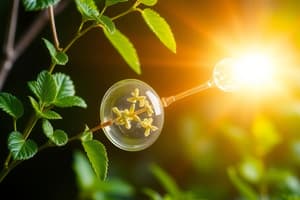Podcast
Questions and Answers
Which process converts glucose and oxygen into energy?
Which process converts glucose and oxygen into energy?
- Cellular Respiration (correct)
- Transpiration
- Photosynthesis
- Fermentation
What is the primary location where photosynthesis occurs in plant cells?
What is the primary location where photosynthesis occurs in plant cells?
- Cytoplasm
- Nucleus
- Chloroplasts (correct)
- Mitochondria
What type of nutrition is characterized by organisms producing their own food?
What type of nutrition is characterized by organisms producing their own food?
- Heterotrophic Nutrition
- Absorptive Nutrition
- Autotrophic Nutrition (correct)
- Symbiotic Nutrition
Which type of reproduction involves genetic variation among offspring?
Which type of reproduction involves genetic variation among offspring?
In which stage of growth do cells specialize into different types?
In which stage of growth do cells specialize into different types?
Which of the following macronutrients is primarily responsible for energy provision?
Which of the following macronutrients is primarily responsible for energy provision?
What is the main byproduct of photosynthesis?
What is the main byproduct of photosynthesis?
Which factor does NOT influence growth and development in organisms?
Which factor does NOT influence growth and development in organisms?
Flashcards are hidden until you start studying
Study Notes
Photosynthesis
- Definition: The process by which green plants, algae, and some bacteria convert light energy into chemical energy.
- Location: Occurs primarily in the chloroplasts of plant cells.
- Equation:
- 6 CO₂ + 6 H₂O + light energy → C₆H₁₂O₆ + 6 O₂
- Importance:
- Produces glucose for energy and oxygen as a byproduct.
- Forms the base of the food chain.
Cellular Respiration
- Definition: The process by which cells convert glucose and oxygen into energy (ATP), carbon dioxide, and water.
- Location: Takes place in the mitochondria of cells.
- Equation:
- C₆H₁₂O₆ + 6 O₂ → 6 CO₂ + 6 H₂O + energy (ATP)
- Types:
- Aerobic Respiration: Requires oxygen; produces more energy.
- Anaerobic Respiration: Occurs in the absence of oxygen; produces less energy (e.g., fermentation).
Nutrition In Organisms
- Definition: The process by which organisms obtain and utilize food for energy, growth, and maintenance.
- Types:
- Autotrophic Nutrition: Organisms (e.g., plants) produce their own food via photosynthesis or chemosynthesis.
- Heterotrophic Nutrition: Organisms (e.g., animals) obtain food by consuming other organisms.
- Nutrient Types:
- Macronutrients: Carbohydrates, proteins, and fats.
- Micronutrients: Vitamins and minerals.
Reproduction In Species
- Definition: The biological process by which new individual organisms are produced.
- Types:
- Asexual Reproduction: Involves a single parent; offspring are genetically identical (e.g., binary fission, budding).
- Sexual Reproduction: Involves two parents; offspring have genetic variation (e.g., fertilization).
- Importance: Ensures species survival and genetic diversity.
Growth And Development
- Definition: The processes through which organisms increase in size and undergo changes throughout their life cycle.
- Stages:
- Cell Division: Involves mitosis (growth and repair) and meiosis (gamete formation).
- Differentiation: Cells specialize into different types (e.g., muscle, nerve).
- Factors Influencing Growth:
- Genetics, environmental conditions, nutrient availability, and hormonal regulation.
- Importance: Essential for organism survival, reproduction, and adaptation to changing environments.
Photosynthesis
- Converts light energy into chemical energy via chloroplasts in plants, algae, and some bacteria.
- Chemical equation: 6 CO₂ + 6 H₂O + light energy → C₆H₁₂O₆ + 6 O₂.
- Produces glucose, a vital energy source, and oxygen as a byproduct.
- Fundamental process supporting the food chain and ecosystem.
Cellular Respiration
- Converts glucose and oxygen into energy (ATP), carbon dioxide, and water within mitochondria.
- Chemical equation: C₆H₁₂O₆ + 6 O₂ → 6 CO₂ + 6 H₂O + energy (ATP).
- Two types:
- Aerobic Respiration: Requires oxygen; yields more energy.
- Anaerobic Respiration: Occurs without oxygen; produces less energy, exemplified by fermentation.
Nutrition In Organisms
- Process of obtaining and utilizing food for energy, growth, and maintenance.
- Two major types:
- Autotrophic Nutrition: Organisms like plants create their own food (photosynthesis or chemosynthesis).
- Heterotrophic Nutrition: Organisms like animals consume other organisms for food.
- Nutrient types include:
- Macronutrients: Carbohydrates, proteins, fats essential for energy and growth.
- Micronutrients: Vitamins and minerals necessary for health and development.
Reproduction In Species
- Biological process enabling the production of new organisms.
- Types include:
- Asexual Reproduction: Involves one parent; offspring are clones (e.g., binary fission, budding).
- Sexual Reproduction: Involves two parents; offspring exhibit genetic variation (e.g., fertilization).
- Vital for species survival and fostering genetic diversity within populations.
Growth And Development
- Process of size increase and changes throughout an organism's life cycle.
- Stages are:
- Cell Division: Includes mitosis for growth and repair, and meiosis for gamete formation.
- Differentiation: Cells specialize into specific types such as muscle or nerve cells.
- Influencing factors include genetics, environmental conditions, nutrient availability, and hormones.
- Critical for survival, reproduction, and adapting to environmental changes.
Studying That Suits You
Use AI to generate personalized quizzes and flashcards to suit your learning preferences.




